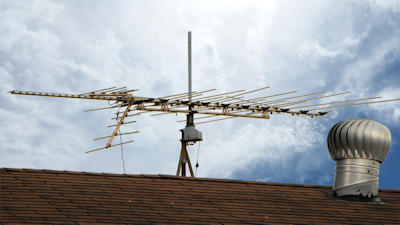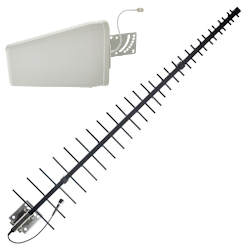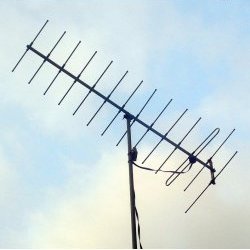Knowledge Base
What’s the difference between an LPDA antenna and a Yagi antenna?
This article explains the technical differences between two types of directional antennas.
Background: Parts of a cell phone signal booster system
- The booster, which amplifies cell signal.
- An outdoor donor antenna that sends and receives signal from a cell tower.
- One or more indoor broadcast antennas that send and receive signal to and from phones and other cellular devices.
- Coax cables that connect the antennas to the booster.
Broadly speaking, there are two types of outdoor donor antennas:
- A directional antenna that’s pointed at a specific cell tower.
- An omnidirectional antenna that communicates with cell towers in all directions.
This article is about directional antennas.
How a directional antenna works
(This explanation has been highly simplified.)
As the term directional indicates, this type of antenna works by being pointed (or focused) at the source of the signal.
 Figure 1: Radiation pattern of a directional antenna. The antenna is at the center; “up” (0°) is the direction the antenna is pointed. (Image: Wilson Connectivity)
Figure 1: Radiation pattern of a directional antenna. The antenna is at the center; “up” (0°) is the direction the antenna is pointed. (Image: Wilson Connectivity)
A directional antenna’s signal pattern can be compared to the light from a flashlight: It’s strongest at the center of the beam and its energy tapers off the farther you get from the center of the beam. Similarly, a directional antenna has a horizontal beamwidth of 40 to 80 degrees (depending on the antenna) from its centerline. The center of the beam (the boresight) is the area of strongest signal reception. (Figure 1.)
A directional antenna consists of a long boom with a series of conductive metal rods, called dipole elements. A dipole element must be bilaterally symmetrical—the same length on one side of the boom as its counterpart on the other side. The combined span of two dipole elements is half the width of the wavelength of the frequency it transmits and receives; this is called a half-wave dipole.
 Figure 2: A rooftop television dipole antenna. (Image: Wikimedia Commons)
Figure 2: A rooftop television dipole antenna. (Image: Wikimedia Commons)
If you grew up before the 1990s, you may remember when every house had a huge television antenna mast on its roof (Figure 2); that’s an example of a dipole directional antenna.
Types of directional building antennas
 Figure 3: The dipole elements on an LPDA antenna increase in length along the boom, forming a triangular shape. Some LPDAs cover their elements in a plastic enclosure (top left) for protection and aesthetic reasons.
Figure 3: The dipole elements on an LPDA antenna increase in length along the boom, forming a triangular shape. Some LPDAs cover their elements in a plastic enclosure (top left) for protection and aesthetic reasons.
An LPDA (log-periodic dipole array) antenna is an assembly of dipole elements, with each dipole element on the boom longer than the one in front of it, giving the antenna a triangular shape (Figure 3). Because it has many dipole elements of different lengths, an LPDA antenna can transmit and receive across a wide range of frequencies.
 Figure 4: The dipole elements on a Yagi antenna are the same length or nearly the same length along the boom. The closed loop near the back of the antenna is the feed element. (Image: Wikimedia Commons)
Figure 4: The dipole elements on a Yagi antenna are the same length or nearly the same length along the boom. The closed loop near the back of the antenna is the feed element. (Image: Wikimedia Commons)
Many people—including some cell signal booster manufacturers—refer to LPDA antennas as “Yagi antennas,” but that’s not accurate. A Yagi–Uda antenna (named for the two Japanese engineers who invented the design) looks similar to an LPDA, but there are important technical differences between the two. The most important difference is that the dipole elements on a Yagi antenna are nearly the same length along the entire boom (Figure 4). Another difference is that only one pair of elements (the feed element or driven element) transmits and receives signal; the other elements direct or reflect the signal to the feed element. Because the dipole elements are similar in width and only one pair of elements is active, the Yagi antenna design works on a single frequency or a very narrow range of frequencies.
In summary:
- A Yagi antenna operates in a very narrow frequency range with higher gain. It’s a narrow-bandwidth antenna.
- An LPDA antenna operates in a wide frequency range with lower gain. It’s a wide-bandwidth (or “wideband”) antenna.
Because a cellular Yagi antenna can only operate in a narrow frequency range, this antenna design is ideal for public safety systems or other applications where the user only needs to amplify a specific cellular frequency or band.
Most commercial and residential cell phone signal boosters, however, need to be able to operate across a range of frequencies (typically 698–2200 MHz). If a directional antenna is needed for your cell signal booster, it’s best to use an LPDA wideband antenna.
And the old TV antenna back in Figure 2? If you look closely at it again, you’ll see that it combines a Yagi antenna for picking up higher UHF frequencies (the narrow, “sawtooth” boom on the left side, with equal-length dipole elements) with an LPDA antenna for picking up lower VHF frequencies (the wider dipole elements spreading out on the right side).
To learn more about the differences between LPDA and Yagi antennas, watch this video from Poynting:

